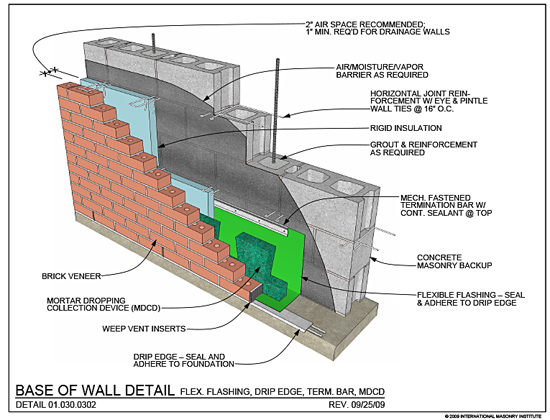Masonry Meets New Energy Codes
R-values are on the increase. For example, in terms of increased R-values, Zone 4 steps up basements for residential and commercial properties. Zone 5 steps up residential basements and commercial wood, and Zone 6 steps up R-values in residential wood frame and commercial wood, and all other occupancy types.
It is important to note the definition of mass walls. According to Section C402.2.3 of the code, mass walls weigh at least 35 lb/ft2 of wall surface area, or 25 lbs./ft2 of wall surface area if material weight is ≤ 120 lb./ft3. Masonry veneers are not mass walls. The Residential Code in Section R402.2.5 says that mass walls are above-grade walls of concrete block, concrete, insulated concrete form (ICF), masonry cavity, brick (other than brick veneer), earth (adobe, compressed earth block, rammed earth) and solid timber/logs. Masonry veneers are not mass walls. They are usually isolated from the interior conditioned air. Architects should not use “Effective” or “Thermal Mass adjusted” R-values for walls and/or products when checking compliance in prescriptive tables. For example, consider the R-value minimum for mass wall vs. wood frame in a non-residential occupancy such as a strip shopping center or fast food restaurant. In every climate zone the mass wall R-value is less than for the frame wall in the same climate zone. Therefore, it is safe to conclude that thermal mass benefits are already included in the tables.
Masonry Compliance with IECC
The following comparative analysis shows how traditional and new masonry systems comply with the IECC 2012, culminating in a chart that assesses each system according to the following parameters: labor rates, R-values / AIA 2030, renovation potential, CI and thermal bridging, water management, acoustical, fire, air barrier, cost, and aesthetics.
Single Wythe Walls
A single wythe wall is a stone, brick, or concrete wall that is one masonry unit thick. It is the most economical wall type as the single layer provides the structure, exterior surface finish and, in some designs, interior surface finish. It is considered durable and inherently fire-proof with fire ratings up to 4 hours. Although the thermal mass and inherent R-values may be sufficient to meet code requirements, particularly in warmer climates, additional insulation may still be required. Rigid insulation inserts, foamed in place or loose fill insulation can be applied to the interior or exterior of the unit. Furring strips can be added to the interior to increase insulation. Alternatively, exterior insulation and finish systems (EIFS) can be added to the exterior. R-values will depend on the density of the concrete, the number and height of the of webs, the depth of CMU as well as the type of insulation calculation method used. With the variety of concrete masonry units and insulation types and thicknesses, R-values from 5 to over 25 are possible. These R-values are relatively low. There is no continuous insulation but if the U-value table is used, continuous insulation is not necessary. Water penetration is sometimes a concern with single wythe walls.
Cavity Walls
Cavity walls consist of two 'skins' separated by a hollow space or cavity, which can be filled with insulation by various methods. A continuous layer of rigid insulation is easily fitted between the cavity and the inner skin of the wall. The cavity itself also helps in insulating the building by acting as a thermal break between the two skins of the wall. The insulated cavity wall adds R-value from the rigid board in the cavity. Board insulation that is 4-5 per inch of thickness times 1-2 inches thick gives an extra R-value of 4 to 10 compared to the single wythe wall. With cavity walls, water management is also superior to that of a single wythe wall, and continuous insulation is achieved. Cavity walls, however, are more costly than single wythe walls; many municipalities, school districts, and other entities consider cavity walls the “Cadillac” of walls.
 |
Energy performance criteria Source: International Masonry Institute |









